Mold. It’s one of the most dreaded words in the English language, and for good reason. Mold can grow anywhere, and it often pops up in some of the most unexpected places – like your suede shoes! If you’ve ever encountered mold on your suede shoes, you know how frustrating it can be to try to remove it. In this article, we will provide a comprehensive guide on how to remove mold from suede shoes. We’ll answer all of your questions, provide useful tips, and show you how to restore your beloved shoes to their former glory!
Why Does Mold Appear on Suede?
Suede leather is a type of leather with a napped finish, giving it a unique velvety appearance. It’s made from the underside of animal skin, usually lamb or deer. Suede is more delicate than other types of leather and can be easily damaged if not cared for properly.
The reason suede is so popular is because of its unique look and feel. Unfortunately, it is also susceptible to mold and mildew. Mold not only spoils the look of your suede shoes, but it can also cause them to deteriorate and fall apart.
If you’ve noticed black spots on your shoes, or they have started to smell musty, then it’s likely that they’re harboring mold. But why would your shoes fall victim to mold in the first place?
Porous nature of leather
Suede leather is much more porous than other types of leather. This means that it can easily absorb water, sweat, and other liquids. When these liquids are not properly dried off, they can lead to the growth of mold and mildew.
Lack of use
One of the main reasons why mold appears on suede shoes is due to lack of use. Suede is a type of leather that needs to be regularly cared for and treated with waterproofing products in order to stay soft and pliable. If you don’t regularly wear your suede shoes, or if you only wear them occasionally, then they’re more likely to develop mold. This is because the natural oils in the leather will start to dry out, making the material more susceptible to moisture and water damage.
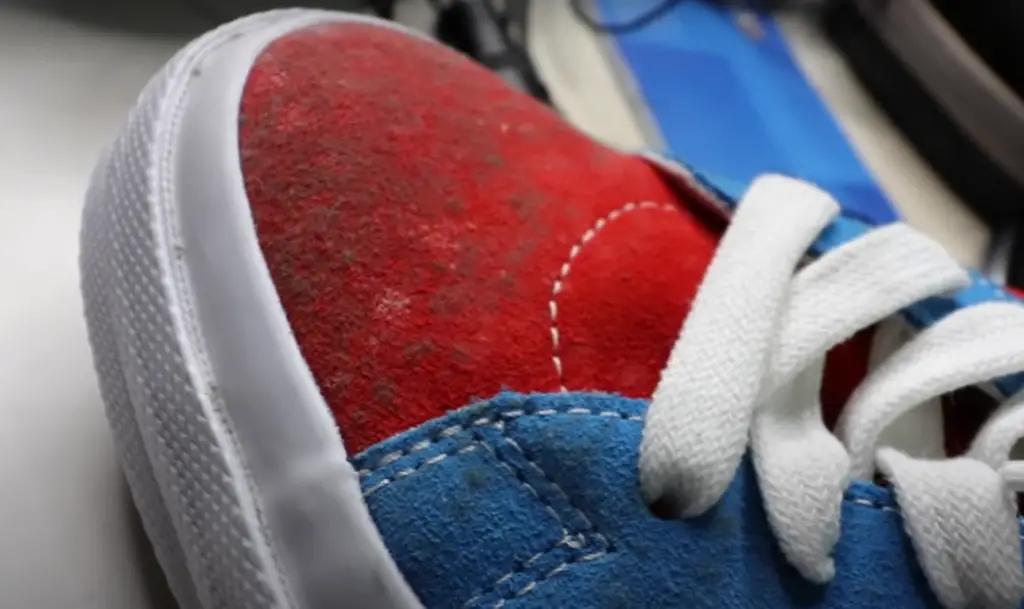
Improper cleaning
And even if you take care to clean your suede shoes regularly, you might still find yourself with a mold problem. That’s because suede is very sensitive to water and detergents. If you’re not careful when cleaning your shoes, you can easily damage the suede, making it more susceptible to mold and mildew.
The best way to clean suede shoes is to use a specialized suede brush. These brushes have soft bristles that won’t damage the leather. You can also use a dry cloth to wipe away any dirt or debris. If your shoes are particularly dirty, you can spot-clean them with a damp cloth. Just be sure to avoid getting the leather too wet.
Damp conditions
The good news is that mold can be removed from suede shoes, but it’s important to act quickly before the problem gets worse.
Poor ventilation
Leather needs to breathe, and suede is no different. When stored in an airtight container or left in a humid environment, spores of mold and mildew can start to grow. If you live in a warm climate, or if your home is particularly humid, then this could be the reason why your shoes have started to develop mold.
Another factor that can contribute to poor ventilation is how you’re storing your shoes. If you’re keeping them in a shoe box, make sure to leave the lid off so that air can circulate. Alternatively, you could invest in a shoe tree which will help to keep your shoes shaped and ventilated.
Thankfully, there is a way to remove mold from suede shoes. However, it’s important to act quickly and to take the proper precautions to avoid damaging the leather. In the following sections, we’ll show you how to remove mold from suede shoes and prevent it from coming back. [1]
Removing Mold From Suede Shoes Using Vinegar
Sometimes the solution to your problem is as simple as using vinegar. White vinegar is the most common type of vinegar, and it’s also the most effective at treating mold. Vinegar is acidic, and it can kill mold spores.
Wear a mask
Mold spores are tiny and invisible to the naked eye. But when they’re airborne, they can be inhaled, and that’s not good for your health. So, it’s important to wear a mask when you’re dealing with mold. A simple dust mask will do the trick.
Prepare your leather garment
Start by taking the leather item outside. If it’s too cold or windy to take the item outside, set up a fan in the room where you’ll be working. The goal is to create as much airflow as possible to prevent mold spores from spreading. Once you’re ready to start, begin by vacuuming the surface of the leather garment with a soft brush attachment. This will remove any loose mold spores that are on the surface of the leather.
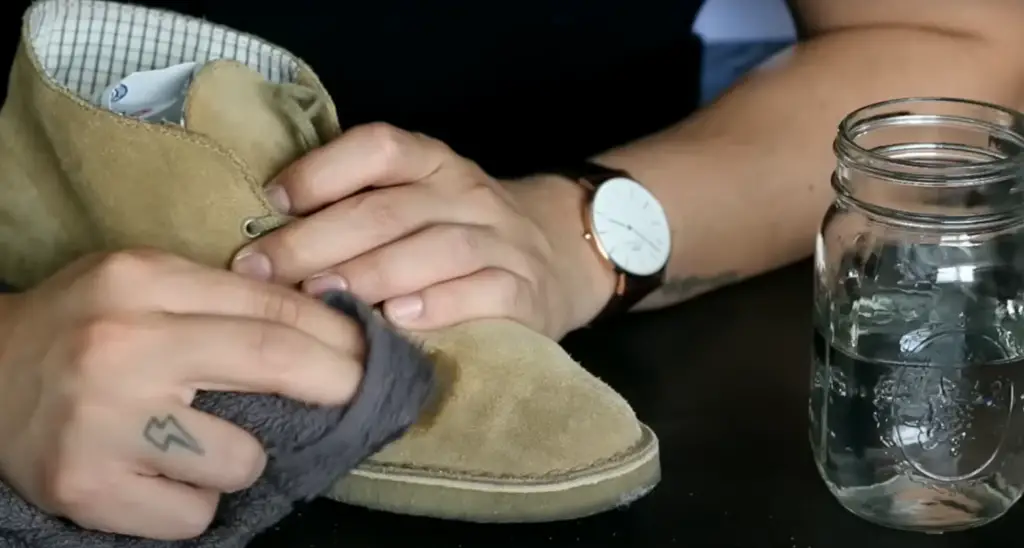
Now it’d be a good idea to wear gloves to protect your hands from the vinegar. If you don’t have gloves, make sure to wash your hands thoroughly after you’re done cleaning the mold.
Brush up
After you’ve vacuumed the leather surface, it’s time to start scrubbing the remaining mold spores with a brush. A soft-bristled brush is best so you don’t damage the leather. A suede brush is ideal, but you can also use a toothbrush. Be sure to clean both the front and back of the leather garment. And wash the brush afterward, you don’t want mold spores infecting anything else.
Apply vinegar
Now it’s time to apply the vinegar solution. As you may know, usually you’d need to dilute the vinegar with water. This time however you’ll be using full-strength vinegar. So, pour some vinegar into a bowl and dip another brush or clean cloth into it. Make sure the brush/cloth is only slightly damp, you don’t want to saturate the leather.
Gently scrub the leather surface with the damp brush/cloth in a circular motion. You should see the mold spores coming off. Once you’ve gone over the entire surface, take a clean cloth and wipe away any excess vinegar.
Dry off
Now it’s time to dry off the leather item. The best way to do this is to let it air dry. Placing your item in a well-ventilated room will speed up the process. Once the item is dry, inspect it to make sure all the mold is gone.
Just make sure the fan is not blowing directly on the item, as this can cause the leather to crack. [2] [3] [4]
Removing Mold From Suede Shoes Using Rubbing Alcohol
Another method that can be used to remove mold from suede shoes is by rubbing alcohol. While it might seem intimidating at first, it is actually a pretty straightforward process. This method will also help to disinfect the area and kill any remaining mold spores.
Work outdoors
Just as with the vinegar solution, you will want to work in an area that is well-ventilated when using rubbing alcohol. This will help to prevent the fumes from getting too strong and making you sick. And, of course, mold spores are notorious for being airborne, so you don’t want to be breathing them in either.
Brush up your suede
Before proceeding with the rubbing alcohol, it is a good idea to give the moldy area a good brush. This will help to loosen up any spores that are clinging to the suede. Be sure to use a soft brush so as not to damage the delicate fabric. It’s also a good call to inspect the garment for stains while you’re at it and treat those accordingly.
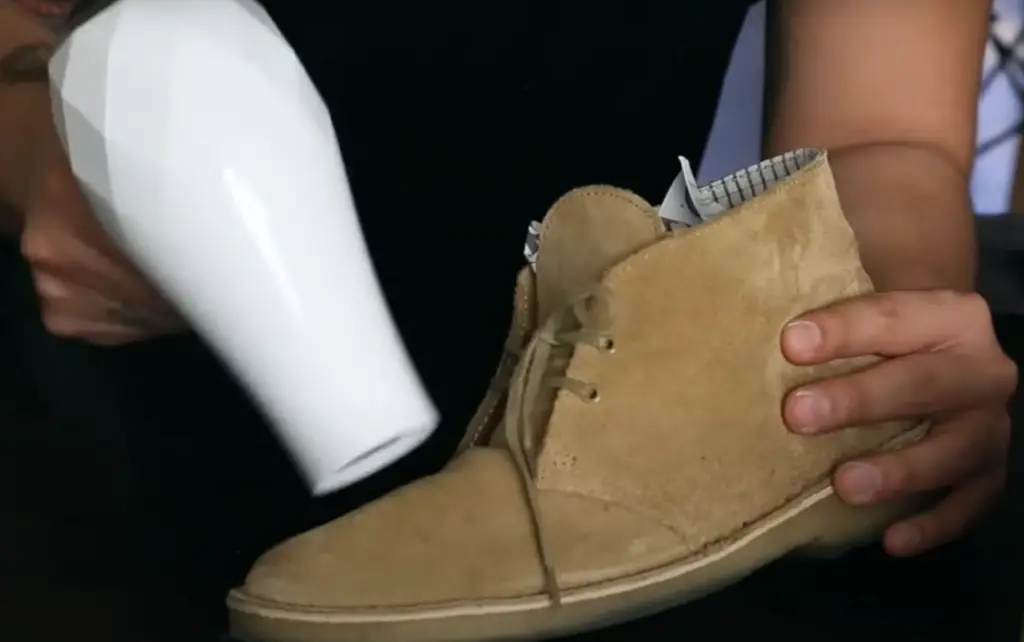
Apply petroleum jelly
Rubbing alcohol has a reputation for being a bit harsh, so you will want to take measures to protect the rest of the shoe from its drying effects. One way to do this is to apply a small amount of petroleum jelly around the perimeter of the moldy area. Petroleum jelly, also known as petrolatum or soft paraffin. Petroleum jelly is used as a lubricant and a protective ointment. It can also be used to treat minor cuts and burns. Applying it will create a barrier that will help to keep the alcohol from seeping into other areas and causing damage. Let the leather absorb the petroleum jelly for about 10 minutes before moving on to the next step.
Soak a cotton ball in rubbing alcohol
Once you have prepared the shoe, it is time to start treating the mold itself. First, dilute the rubbing alcohol by adding an equal amount of water to the bottle. This will help to cut down on its drying effects. Again, be sure to do a spot test on an inconspicuous area of the shoe to make sure the alcohol won’t damage the suede.
Once you have verified that it is safe to proceed, soak a cotton ball in the diluted rubbing alcohol. You don’t want to saturate the suede, so be sure to wring out the cotton ball well before using it.
Gently rub the cotton ball over the moldy area in a circular motion. Be sure to apply a good amount of pressure to loosen up any spores that are clinging to the suede.
Wipe away the remaining alcohol and mold
Once you have treated the area with rubbing alcohol, use a clean cloth to wipe away any remaining residue. Be sure to dispose of the used cotton balls and clothes properly to avoid spreading mold spores.
You may need to repeat this process a few times to completely remove all of the mold. And as always, be sure to allow the suede time to dry completely in between treatments.
Allow the shoe to dry
After you have removed all of the mold, allow the shoe to air dry in a well-ventilated area. Be sure to turn the shoe over so that both sides have a chance to dry completely. This process can take a few hours, so be patient.
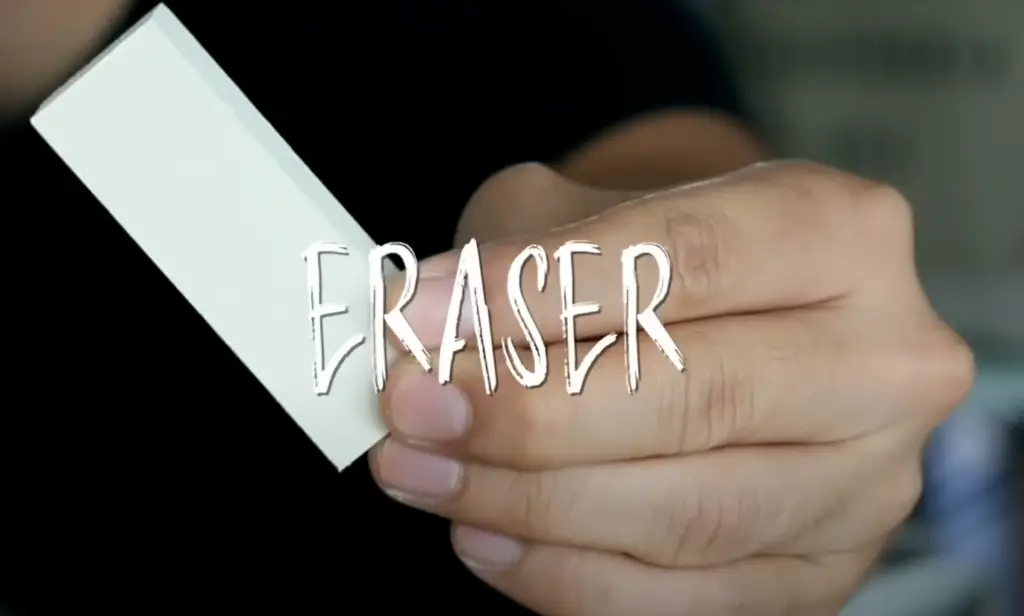
Do not put the shoe in direct sunlight, as this can cause the suede to fade. And of course, do not put the shoe in the dryer as this will damage the delicate fabric. [1] [3] [4]
Preventing Mold on Suede Shoes
Of course, the best way to deal with mold is to prevent it from happening in the first place. Here are a few tips that will help you keep your suede shoes mold-free:
Avoid wearing your shoes in a wet environment
Suede just isn’t meant to get wet. If you must wear your shoes in the rain or snow, be sure to treat them with a water repellent before heading out. And as soon as you come home, take off your shoes and let them dry completely before storing them away.
Inspect your shoes regularly
Check your suede shoes periodically for signs of mold, such as discoloration, musty odors, or fuzzy patches. If you catch mold early, you’ll have a much easier time removing it.
Clean your shoes regularly
Suede is a delicate material, so it’s important to clean it regularly and gently. Use a soft brush to remove dirt and debris, and be sure to treat any stains as soon as possible.
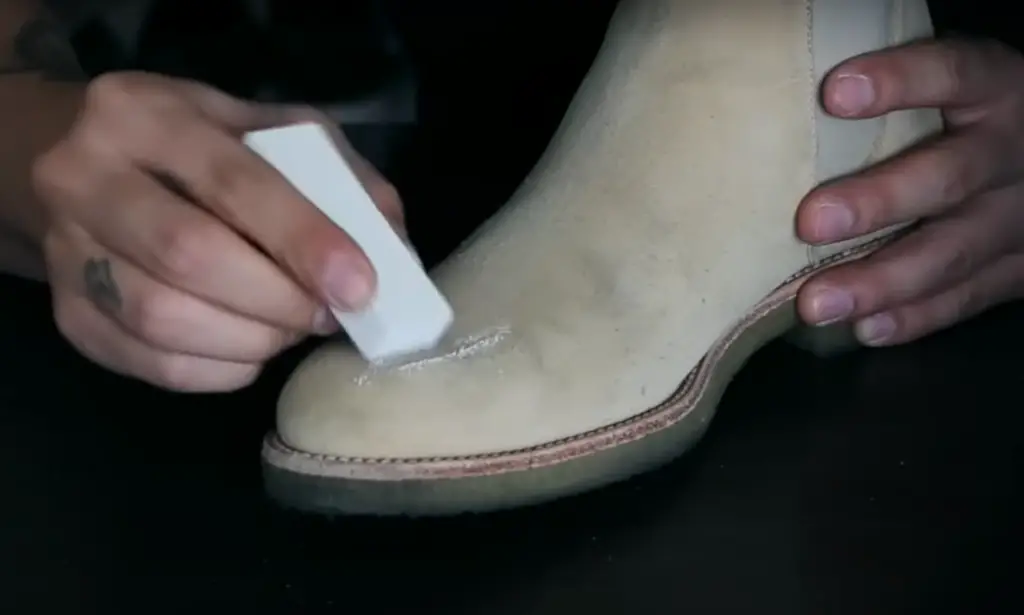
You can also use a suede cleaner once a few months to keep your shoes looking their best. [2]
FAQ
Can you get rid of mold on the suede using bleach?
While technically you can use bleach to kill mold spores, it’s not recommended for a few reasons. First, it will likely damage the suede and change its color. Second, it’s a harsh chemical that can be dangerous to you and your environment if used improperly. And third, there are much gentler and more effective ways to remove mold from suede.
Why have my suede shoes gone moldy?
Mold spores are everywhere, both indoors and outdoors. A suede is a type of leather that is made from the inner split of a hide. It has a napped surface that can be brushed to create a hairy effect. Suede is less expensive than full-grain leather and is often used to make clothing and footwear. Because it’s porous, suede can absorb moisture from the air, which makes it susceptible to mold growth.
If you live in a humid climate or your home has poor ventilation, this can cause your suede shoes to develop mold. Wearing them in wet conditions, such as walking in the rain or through puddles, can also lead to mold growth.
Can mold on shoes be removed?
Yes, it is possible to remove mold from suede shoes. However, it is important to be careful when attempting to do so, as mold can cause damage to the material. There are a few different methods that can be used to remove mold from suede shoes, which include using vinegar, bleach, or alcohol. It is also important to ensure that the shoes are completely dry before storing them, as mold thrives in damp environments. When cleaning them, use a soft brush or cloth and avoid getting the material too wet. After cleaning, let your shoes air dry in a well-ventilated area.
How do you get mold off suede and leather?
Removing mold from suede and leather can be a tricky process. If the mold is on the surface of the material, you may be able to remove it with a stiff brush or by rubbing the area with a dry cloth. If the mold has penetrated the fibers of the fabric, you’ll need to take more aggressive measures.
One method for removing mold from suede is to use rubbing alcohol. Apply the alcohol to a clean cloth and rub it over the moldy area. This will kill the mold and remove any spores that are present. You can also try using white vinegar or Hydrogen peroxide.
If the above methods don’t work, you may need to use a commercial suede cleaner. These cleaners are designed to penetrate deep into the fabric and break up any mold that is growing inside of it. Be sure to follow the directions on the cleaner carefully and test it on an inconspicuous area of the shoe first.

How do you get mold out of black suede?
To remove mold from black suede, you will need to use plain white vinegar. Soak a clean cloth in the vinegar and then use it to gently rub the moldy areas of the shoe. You may need to do this a few times to remove all of the mold.
If you are worried about damaging the suede, you can also try using a brush with soft bristles to remove the mold. Gently scrub the affected areas of the shoe with the brush until all of the mold is gone.
Just be sure to perform this cleaning process in a well-ventilated area or outside so that the mold spores do not spread to other areas of your home.
Useful Video: How To Clean Your Suede Sneakers | The Best Method Possible
Conclusion
Suede shoes are a popular choice for many people because of their sophisticated look and feel. Unfortunately, they are also susceptible to mold and mildew growth. If you expose your suede shoes to damp or humid conditions, the mold may start to grow and spread quickly.
If you notice mold or mildew growing on your suede shoes, it’s important to take action right away. You’ll need to clean the shoes as soon as possible to prevent the mold from spreading and causing further damage.
There are a few different ways that you can remove mold from suede shoes. You can use white vinegar or rubbing alcohol. Whichever method you choose, be sure to follow the instructions carefully and take care not to damage the suede in the process. With a little effort, you can get rid of the mold and keep your suede shoes looking great.
But of course, prevention is always the best cure. The best way to avoid having to deal with moldy suede shoes is to keep them stored in a cool, dry place. If you’re going to be wearing them in wet or humid conditions, be sure to take them off as soon as possible and allow them to air out and dry completely before putting them away. By taking these simple precautions, you can keep your suede shoes looking like new for many years to come. Thanks for reading!
References:
- https://krostrade.com/blog/how-to-remove-mold-from-suede-shoes/
- https://www.ehow.com/how_5979118_remove-mold-suede.html
- https://www.magicofclothes.com/remove-mold-from-suede-shoes/
- https://www.tipsbulletin.com/how-to-remove-mold-from-suede-shoes/

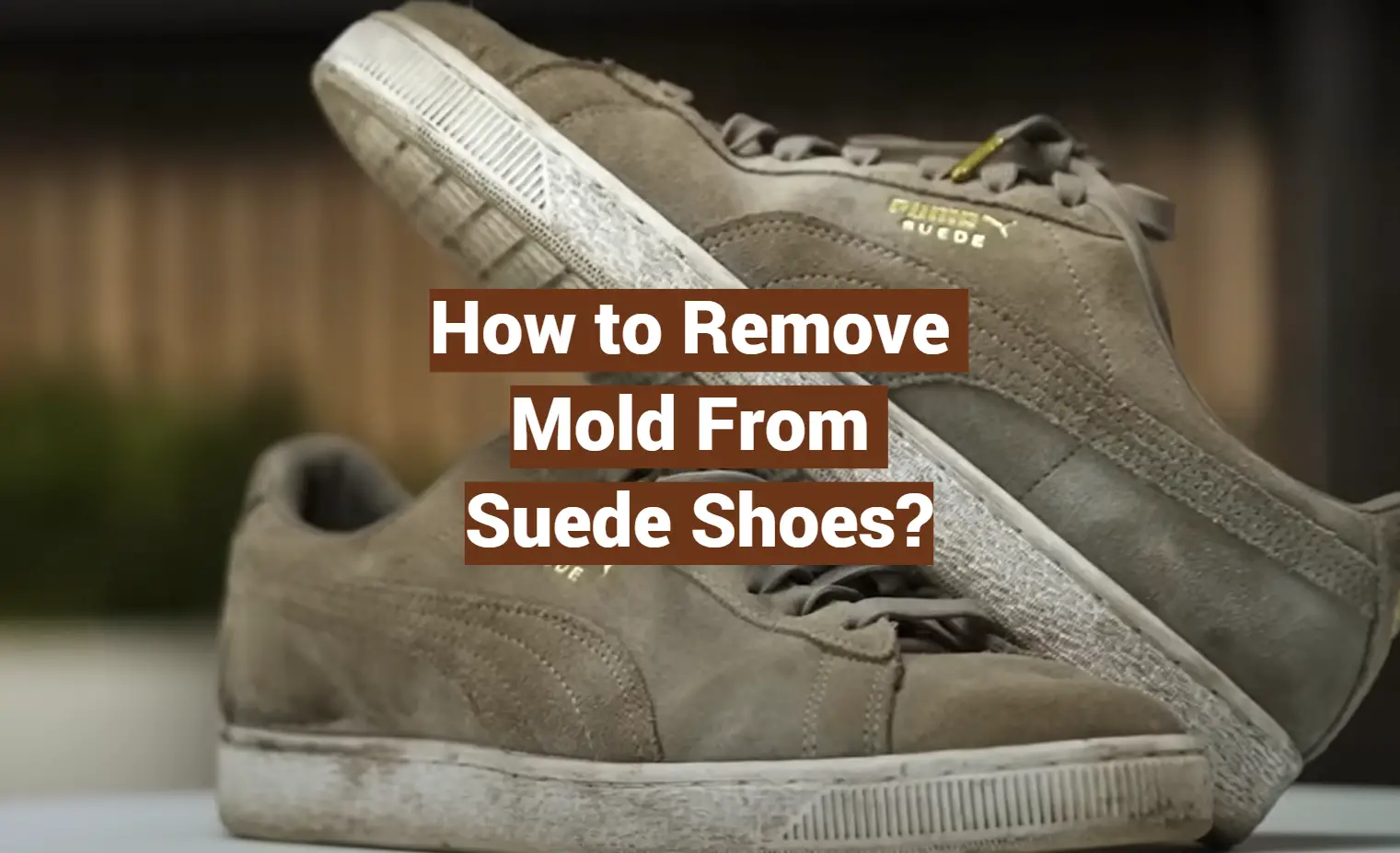

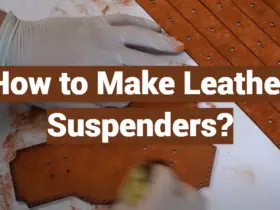

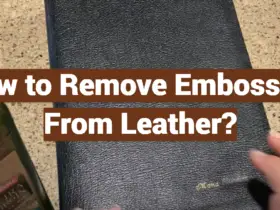

I’ve had issues with mold on my suede shoes in the past, which is so frustrating! The best method I’ve found is to use a suede brush or eraser to gently rub it off. You have to be patient and work in circles to slowly lift the mold away without damaging the material underneath. Using something abrasive like sandpaper can ruin suede.
Mold loves growing on suede because of the texture, so moisture and humidity are its best friends. I’ve learned to store my suede shoes with silica packets or cedar blocks to absorb excess moisture and prevent mold from returning. Proper storage is key!
Once I noticed the greenish mold spots on my favorite pair of tan suede boots, I freaked out. After some research, I used a 50/50 solution of white vinegar and water to lightly scrub with a toothbrush. It took a couple treatments, but the mold came right off and my boots were saved!
I was so annoyed when I got my suede purse back from storage and found mold all over the bottom. I tried brushing it first but that didn’t work. Then I used a suede cleaner with a microfiber cloth which helped a lot. Just don’t over-scrub or you might damage the material. Gentle pressure is best with suede.
After getting caught in the rain, my suede jacket ended up with mold spots. I was able to get rid of them by using a small amount of rubbing alcohol on a cotton pad and lightly dabbing the area. It dried quickly and didn’t leave any moisture behind to reactivate the mold. Phew!
I almost tossed my favorite suede heels when I discovered the gross mold on them. As a last ditch effort, I used a mold killing spray meant for other fabrics and it worked amazingly! The suede looked good as new after air drying. Definitely give sprays a try before throwing suede away.
Ugh, I left my suede gloves in a damp bag over the winter and they became dotted with mold. I was able to rub most of it off with a pencil eraser. For the stubborn spots, I used a tiny bit of baking soda as a gentle abrasive. Just be careful not to rub too hard on suede and damage it.
I learned the hard way not to store suede items in sealed plastic bags! My shoes were covered in mold when I opened the bag. Luckily I was able to use a suede stone bar to buff away the mold gently. Be sure to fully dry shoes afterwards. Air circulation is key!
While looking for mold removal tips online, I saw someone recommend using a dry sponge to lightly brush it off suede. I tried it on my hat and was impressed with how well it worked. You have to be extremely gentle and patient, but the sponge lifted most of the mold off.
After finding mold on my favorite suede jacket, I sprinkled some corn starch on the spots and let it sit overnight to absorb moisture. I used a lint roller in the morning and it removed most of the mold along with the corn starch. Just be sure to fully dry suede before storing again.
Ugh, I was so mad when I found mold all over my cute suede booties! I was able to get the mold off using soft brush attachment on my vacuum cleaner. I just gently brushed over the surface repeatedly until the mold was lifted away. Gotta keep suede dry to avoid this headache again!
I was able to save my suede shoes from mold spots by using a laundry stain remover stick and gently dabbing the affected areas. I let it dry fully before brushing the residue away with a suede brush. It made the suede like new again without damage! Just never use water or wash suede in a machine.